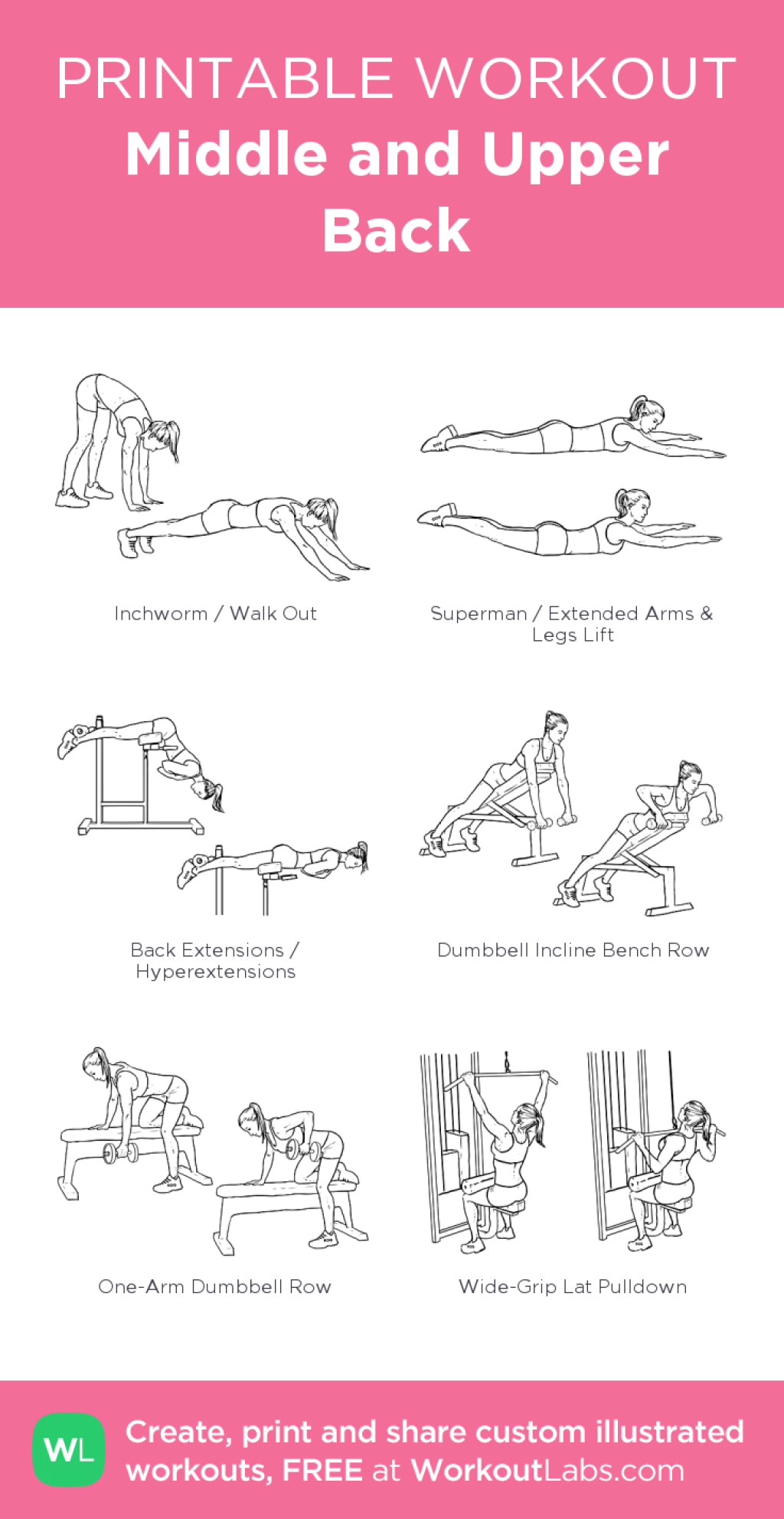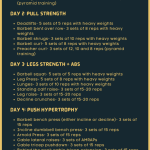Power Up Your Upper Back With An Effective Workout Routine: Click To Transform!
Workout Routine for Upper Back: Strengthen Your Muscles and Improve Posture
Greetings, dear readers! Today, we are going to dive into the world of upper back workouts. Strengthening your upper back is crucial for maintaining good posture, preventing back pain, and improving overall upper body strength. In this article, we will explore various exercises and techniques that will help you achieve a strong and healthy upper back. Let’s get started!
Introduction
The upper back, also known as the thoracic spine, plays a vital role in our daily activities. Whether it’s sitting at a desk, carrying heavy objects, or participating in sports, a strong upper back is essential for proper movement and stability. However, due to our sedentary lifestyles and poor posture, many individuals experience weak upper back muscles and related issues.
1 Picture Gallery: Power Up Your Upper Back With An Effective Workout Routine: Click To Transform!

In this workout routine, we will focus on exercises that target the muscles in the upper back, such as the trapezius, rhomboids, and rear deltoids. By incorporating these exercises into your fitness regimen, you can improve your posture, reduce the risk of injury, and enhance your overall strength and performance.
Before starting any workout routine, it’s important to consult with a healthcare professional, especially if you have any pre-existing medical conditions or injuries. Remember to listen to your body and modify the exercises as needed. Now, let’s delve into the details of the workout routine for the upper back.
What: Exercises to Strengthen the Upper Back
1. Bent-Over Rows 💪

Image Source: pinimg.com
Start by standing with your feet shoulder-width apart and knees slightly bent. Hold a dumbbell in each hand with your palms facing your body. Bend forward at the hips while keeping your back straight. Slowly lift the dumbbells towards your chest, squeezing your shoulder blades together. Lower the weights back down and repeat for the desired number of repetitions.
2. Pull-Ups 💪
Find a sturdy pull-up bar and grip it with your palms facing away from you. Hang freely with your arms fully extended. Engage your upper back muscles and pull your body upward until your chin is above the bar. Lower yourself back down with control and repeat.
3. Reverse Flyes 💪
Begin by standing with your feet hip-width apart and knees slightly bent. Hold a dumbbell in each hand with your palms facing each other. Lean forward, hinging at the hips, until your upper body forms a 45-degree angle with the ground. Lift your arms out to the sides, squeezing your shoulder blades together. Slowly lower the weights back down and repeat.
4. Superman 💪
Lie face down on an exercise mat with your arms extended in front of you and your legs straight. Lift your arms, chest, and legs off the ground simultaneously, engaging your upper back muscles. Hold the position for a few seconds, then lower yourself back down and repeat.
5. Resistance Band Pull-Aparts 💪
Stand with your feet shoulder-width apart and hold a resistance band in front of you with your palms facing down. Keeping your arms straight, pull the band apart until your hands are in line with your shoulders. Slowly return to the starting position and repeat.
6. Prone Ys and Ts 💪
Lie face down on an exercise mat with your arms extended overhead in a Y position. Lift your arms off the ground, squeezing your shoulder blades together. Return to the starting position and then move your arms out to the sides, forming a T position. Again, lift your arms off the ground, engaging your upper back muscles. Repeat the Y and T movements for the desired number of repetitions.
Who: Who Can Benefit from Upper Back Workouts?
Upper back workouts are beneficial for individuals of all fitness levels and ages. Whether you are a beginner or an experienced athlete, incorporating exercises that target the upper back muscles will help improve your posture, increase upper body strength, and prevent back pain. These workouts are particularly useful for individuals who spend long hours sitting or have jobs that require repetitive upper body movements.
When: When Should You Include Upper Back Workouts in Your Fitness Routine?
Upper back workouts can be incorporated into your fitness routine two to three times per week. It’s important to allow your muscles to rest and recover between workouts, so avoid consecutive days of intense upper back exercises. For optimal results, consider alternating upper back workouts with other muscle groups or engaging in cardiovascular activities.
Where: Where Can You Perform Upper Back Workouts?
Upper back workouts can be done at home, in a gym, or any location with minimal equipment. Many of these exercises require only dumbbells or resistance bands, making them easily accessible for home workouts. If you prefer a gym setting, you can utilize cable machines, pull-up bars, or other equipment specifically designed for upper back exercises.
Why: The Benefits of Incorporating Upper Back Workouts into Your Fitness Routine
1. Improved Posture 💪
Strengthening the muscles in your upper back helps align your spine, improving your posture and reducing the risk of developing rounded shoulders or a hunched back.
2. Injury Prevention 💪
A strong upper back provides stability and support for the spine, reducing the risk of injury during daily activities or sports that involve upper body movements.
3. Enhanced Upper Body Strength 💪
By targeting the muscles in your upper back, you can increase your overall upper body strength, allowing you to perform various exercises and activities with greater ease and efficiency.
4. Reduced Back Pain 💪
Strengthening your upper back can alleviate back pain caused by poor posture or weak muscles. These exercises help alleviate tension and promote better spinal alignment.
5. Improved Performance in Sports and Daily Activities 💪
A strong upper back enhances your performance in sports that involve upper body movements, such as swimming, tennis, or weightlifting. Additionally, daily activities like carrying heavy objects or children become easier with a well-conditioned upper back.
How: How to Perform Upper Back Workouts Safely and Effectively
1. Warm Up 💪
Before starting any upper back workout, it’s essential to warm up your muscles and increase blood flow to the targeted area. Engage in light cardio exercises, such as jogging or jumping jacks, for 5-10 minutes, followed by dynamic stretches for the upper back and shoulders.
2. Start with Light Weights 💪
If you are a beginner or returning to exercise after a break, start with light weights to ensure proper form and technique. Gradually increase the weight as your strength improves.
3. Focus on Proper Form 💪
When performing upper back exercises, maintain proper form and technique to avoid injury. Keep your back straight, engage your core muscles, and avoid using momentum to lift the weights.
4. Breathe 💪
Remember to breathe throughout each exercise. Inhale before initiating the movement and exhale during the exertion phase.
5. Listen to Your Body 💪
If you experience any pain or discomfort during an exercise, stop immediately and consult with a healthcare professional. It’s important to listen to your body and modify the exercises as needed.
Advantages and Disadvantages of Upper Back Workouts
Advantages:
1. Improved posture and alignment
2. Increased upper body strength
3. Reduced risk of back pain and injuries
4. Enhanced performance in sports and daily activities
5. Versatile exercises that can be done anywhere
Disadvantages:
1. Requires consistent commitment and effort
2. Potential for muscle soreness and fatigue
3. In some cases, additional equipment may be required
4. Possible risk of injury if exercises are performed with incorrect form
5. Not suitable for individuals with certain medical conditions or injuries
Frequently Asked Questions (FAQs)
1. Q: Can I do upper back workouts if I have a history of back pain?
A: It’s important to consult with a healthcare professional before starting any exercise routine, especially if you have a history of back pain. They can provide personalized guidance and recommend suitable exercises for your condition.
2. Q: How long does it take to see results from upper back workouts?
A: The time to see results varies from person to person. Consistency and proper technique are key factors in achieving desired outcomes. With regular workouts, you can expect to see improvements in posture and strength within a few weeks to a couple of months.
3. Q: Can I do upper back workouts at home without any equipment?
A: Yes, there are several upper back exercises that can be done without equipment, such as supermans, wall slides, and cat-camel stretches. However, incorporating resistance bands or dumbbells can add variety and intensity to your workouts.
4. Q: How often should I change my upper back workout routine?
A: It’s beneficial to switch up your workout routine every 4-6 weeks to prevent plateaus and keep your muscles challenged. Introducing new exercises or increasing the intensity can help you continue progressing toward your fitness goals.
5. Q: Can upper back workouts help with rounded shoulders?
A: Yes, targeted upper back exercises can help improve rounded shoulders by strengthening the muscles that support proper posture. Combined with stretching exercises for the chest and front shoulder muscles, these workouts can help restore balance to your upper body.
Conclusion: Take Action for a Stronger Upper Back
Now that you have gained a comprehensive understanding of upper back workouts, it’s time to take action. Incorporate these exercises into your fitness routine and reap the benefits of a stronger and healthier upper back. Remember to start gradually, focus on proper form, and listen to your body. With consistency and dedication, you can achieve improved posture, enhanced strength, and a reduced risk of back pain. So, what are you waiting for? Let’s get started on our journey to a stronger upper back!
Disclaimer: The information provided in this article is for educational purposes only. It is not intended to be a substitute for professional medical advice, diagnosis, or treatment. Consult with a healthcare professional before starting any exercise program or making significant changes to your fitness routine.
This post topic: Workout Routines


